The Maasai who originated from North of Lake Turkana, north west Kenya in the lower Nile valley and began migrating southward during the 15th century, with their rich and extraordinary culture. are Perhaps the most renowned tribe in Africa.
They are semi-nomadic ethnic group primarily found in Kenya and Tanzania, and are renowned for their rich cultural heritage, distinctive customs, and deep connection to the land. This feature delves into the unique aspects of the Maasai, exploring their diet, traditional attire, symbols, social structure, and cultural taboos.
According to history ,the Maasai are among the last great warrior cultures globally, with their historical territories including the Serengeti—derived from the Maasai word “Serengit,” meaning endless plains—and the Maasai Mara in Kenya. While these areas are now designated wildlife reserves and largely uninhabited, the Maasai continue to maintain their homesteads on the outskirts and throughout the Ngorongoro Highlands. Acquiring cattle from other tribes as they moved .
In 1911, a treaty with British settlers led to the controversial loss of much of their prime land. Following this hardship, they encountered European settlers,forcing the Maasai to relocate to less fertile areas in Kenya and Tanzania.
Unfortunately, this period was marked by severe drought and disease, which decimated nearly half of the Maasai population and their herds.
Known for their Pastorial lifestyle, the Maasai people rely heavily on cattle herding, an activity which serves as the cornerstone of their livelihood. To the Massai, Cattle are not only a source of food—providing milk, meat, and blood—but also serve as a symbol of wealth and status within the community.
This means, Cows are the most prized possessions of the Maasai, and their lives are centered around these animals. Cattle are a symbol of wealth, so the more cows a Maasai owns, the higher their status within the community.

For the Maasai, cows serve as currency, and traditional practices involve exchanging cattle between the families of brides and grooms, which also determines the bride’s price. This means , wives are effectively purchased with cows not with modern day cloths, drinks,rings and money.
The Maasai are known for being among the tallest people in Africa, with many individuals exhibiting a tall and lean physique. This stature is often attributed to their diet, which is rich in calcium from milk and meat.
The skin tone of the Maasai people is typically dark skin ,which is well-adapted to the sun-drenched environments of East Africa. The hair of the traditional Maasai men are often shaven or kept short while women may wear their hair in intricate styles, often adorned with beads or ochre,naturally made with clay earth pigments that ranges in different colors.
The Young warriorslocally known as (morans) sometimes wear their hair long and styled in distinctive ways as part of their initiation rites.
Typically the most recognizable element of the Massai clothing is the “shuka”,a brightly colored cloth worn as a wrap. Sources say the massai cloth, traces its origins to the Scottish kilt, which emerged at the end of the 16th century.
The shúkà is usually red, symbolizing bravery ,strength and resilience. The color red holds significant cultural importance for the Maasai.Traditionally, red is also associated with the blood of cattle, which is central to their existence. However this cloth can also come in other colors and patterns.
The shúkà is made from cotton or wool and is often adorned with intricate beadwork that reflects the wearer’s status and community ties.
Men typically wear it draped over one shoulder, while women may wrap it around their bodies more fully.
The Maasai adorn themselves with elaborate beadwork, which is an essential aspect of their traditional attire. Beaded necklaces, bracelets, earrings, and headbands are common, with different colors and patterns signifying various meanings related to age, status, and community affiliation. Women often wear multiple layers of beads that can be quite elaborate.

The Men often carry sticks, locally known as “fimbos” to protect them from wild animals or enemies. The elderly massai men are usually seen carrying a machete or spear known as (enkoroko) as symbols of their warrior status.
The spear or machete is not only a tool for protection but also a sign of masculinity,bravery,and the responsibility to safeguard the community. Young men undergo rigorous training to also become warriors, which includes learning how to hunt and protect against predators.
Women may carry smaller items such as a walking stick or a gourd for milk.
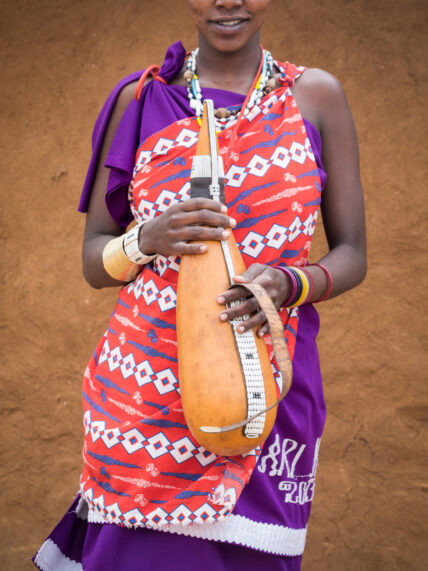
Traditionally, the Maasai go barefoot or wear sandals made from leather or tires. However, in modern day,Massai are slowly embracing the contemporary footwear mostly worn in the cities.

The married Massai men are spotted wearing either a beaded headband or a cap, while their married women wear headpieces embellished with decorated pattens of colours usually white ,to signify her marital status or social standing.

The symbolism in Maasai attire extends beyond color; beadwork plays a crucial role as well. Each bead color has its own meaning—white represents purity, blue symbolizes sky and water, green signifies health and land, and yellow embodies wealth. Together, these colors create a visual language that communicates personal and communal narratives.
The Maasai diet primarily consists of six basic foods , milk , meat, fat, blood , honey and tree bark.
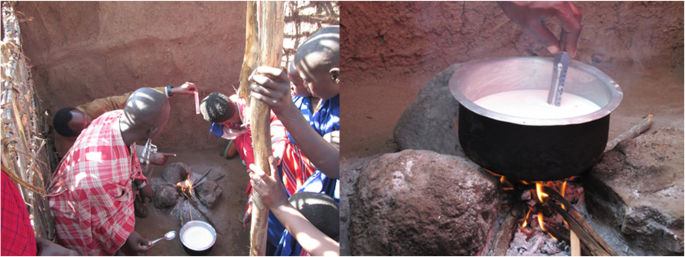
They drink both fresh and curdled milk which is consumed from a calabash (gourd) and is sometimes mixed with fresh cattle blood. The blood can also be boiled and used in cooking or drinks, often accompanied by “monono,” which is more commonly known as ugali. Ugali is a staple food in East Africa made from maize (corn), millet, sorghum, or cassava flour mixed with boiling water and stirred continuously until it reaches a dense, dough-like consistency. Meat is often added to meals, and blood may be consumed during special occasions or for medical needs. This reliance on livestock is deeply woven into their cultural identity, as cattle are regarded as sacred and central to their way of life.

Occasionally the massai drink blood either raw or mixed with milk. This is used as a ritual drink in special celebrations or given to the sick. The modern day massai people are slowing supplementing their traditional blood and meat with tubers and forage plants mostly taken in the form of soups.

Many taboos or prohibitions govern the Massai eating habits , For instance , men are not permitted to eat meat that has been in contact with women or meat that has been handled by an uncircumcised boy after it has been cooked.
Perhaps One of the most famous Maasai traditions is the jumping dance known as ‘Adamu.’ This dance has a deeper significance, as it showcases the strength of the performers and is traditionally intended to attract potential brides. The height of a jump is seen as an indicator of a Maasai warrior’s desirability to female members of the community.
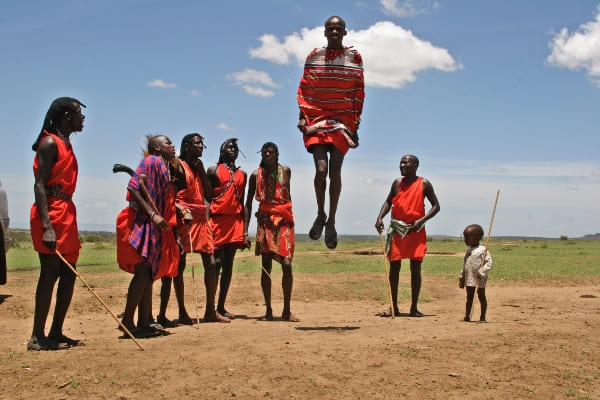
Their vibrant traditions and lifestyle of the Massai have captured the attention of the world, making them one of Africa’s most iconic communities.
Generally the Maasai have a set of cultural taboos that govern behavior and social interactions. These taboos are deeply rooted in their beliefs and traditions, serving to maintain harmony within the community. For instance:It is taboo to harm or kill cattle without just cause, as they are considered sacred. Certain foods such as wild game except antelope , chicken, fish and salt are generally forbidden during specific rituals or rites of passage. Additionally, women are not allowed to cook food for men or be present when it’s cooked during certain periods like the moran warriors’ stay away from the village.
There are strict expectations regarding gender roles; men are expected to be warriors and protectors while women are responsible for cooking, constructing their circular or loaf-shaped huts using mud sticks , grass ,ash cow dung and sometime human urine.
These huts often enclosed with a circular fence built by men, which protects their cattle at night from wildlife. The women are also required to not just manage the homes but to be ready to bear many children and raise them.
When it comes to religion , the Massai people are Monotheistic , Monotheistic. The belief in a single, all-powerful deity they call “Enkai or Engai” meaning God.
This God is considered benevolent and is represented by different colors, such as black for rain and thunder, and red for lightning and the dry season. While many Maasai have also adopted Christianity or Islam, the traditional belief in Enkai remains a significant part of their culture.
Indeed, the Maasai people embody a rich tapestry of tradition, resilience, and cultural pride. Their unique lifestyle, characterized by cattle herding and a deep connection to their land, continues to thrive despite modern challenges. The vibrant colors of their clothing and the meanings embedded in their symbols reflect a profound cultural identity that is both unique and deeply respected. As guardians of their heritage, the Maasai remind us of the importance of tradition in an ever-changing world.


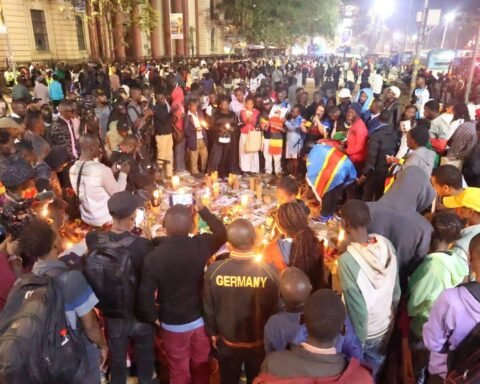
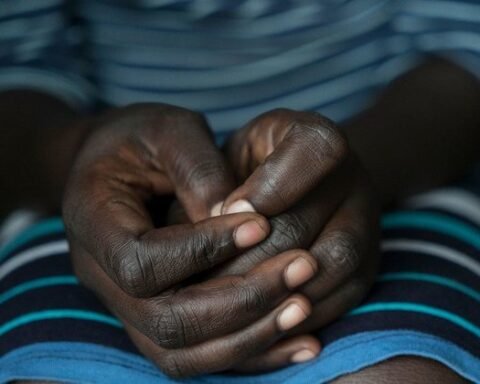

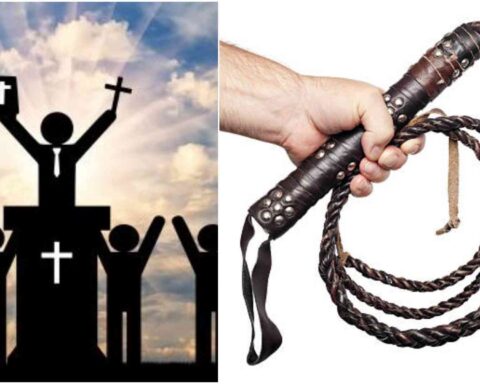


They drink blood? oh wooow, thanks for the insight
My question is why are these people not brushing their teeth and taking their bath,? or is it also part of their culture because frankly they smell so bad..
Socioeconomic factors can play a significant role. Some individuals might not have access to clean water, soap, or dental care products, which can affect their ability to maintain personal hygiene.
My question is why are these people not brushing their teeth and taking their bath,? or is it also part of their culture because frankly they smell so bad..
More reason why government must ensure to fix the many issues facing these people. Foreigners are travelling far and near to use these massais’s for contents on youtube of which they have making millions from.,why is the government not concern about this.They can fox even plan it well and make those places a tourism hub , and give some of the massai to establish businesses .hmmm its sad our we reason in africa…these whites only make fun of us